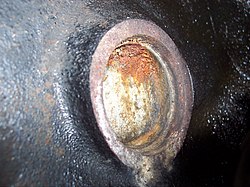


Core plugsorWelch plugs, are used to fill the sand casting core holes found on water-cooled internal combustion engines.
Sand cores are used to form the internal cavities when the engine blockorcylinder head(s) are cast. These cavities are usually the coolant passages. Holes are designed into the casting to support internal sand forms and to facilitate the removal of the sand after the casting has cooled. These holes generally have no factory designed purpose after the sand has been removed although some aftermarket temperature sensors may be installed into the location of a core plug on some engine designs. Another use is to install an aftermarket system designed to act as a block heater which is installed to keep an engine warm due to sub-freezing temperatures as found in far northern climates such as in the state of Alaska. Basically, a core plug is a cap at the end of these passages used to prevent water or a coolant mixture from leaking out of the engine.[1]
Core plugs are usually thin metal cups press fitted into the casting holes, but may be made of rubber or other materials. The most common metal plugs used in automotive engines are made from plated mild steels, stainless steels, brass or bronze. In some high-performance engines the core plugs are large diameter cast metal threaded pipe plugs.[2]
Core plugs can often be a source of leaks due to corrosion caused by cooling system water.[3] Although modern antifreeze chemicals do not evaporate and may be considered "permanent", anti-corrosion additives gradually deplete and must be replenished via a flush and refill. Automotive manufacturers specify time and mileage numbers for cooling system maintenance in their published factory maintenance manuals.
The slang term "freeze plug" was coined many decades ago out of ignorance of the true purpose of the core plugs - they were never designed to be displaced by water freezing inside the block due to a lack of an anti-freeze/water mixture and their displacement is merely coincidental if freezing does occur. The sole purpose of a core plug is to literally act as a plug in the holes designed to be in a casting which allows the casting sand to be removed during the manufacture process. [4]
The Welch plug is a type of core plug that is made from a thin disc of metal. The Welch plug is dome-shaped and inserted into the casting hole with the convex side facing outwards.[5] When installed by striking the Welch plug with a hammer, the dome collapses slightly, expanding it laterally to seal the hole. This differs from other dish-shaped core plug designs, which form a seal when their tapered sides are pressed into the casting hole.[6]
The Welch plug was originally designed in the 1900s at the Welch Motor Car Company in the United States. Prior to the invention of the Welch plug, the core holes were sealed using pipe plugs. During the testing of a car, one of the pipe plugs backed out. In order to get back on the road, one of the Welch brothers installed a press-fit quarter or half dollar coin into the hole using a hammer. The design of the Welch plug was refined based on this principle of a press-fit metallic disc.[7]
|
| |
|---|---|
Part of the Automobile series | |
| Engine block and rotating assembly |
|
| Valvetrain and Cylinder head |
|
| Forced induction |
|
| Fuel system |
|
| Ignition |
|
Engine management |
|
Electrical system |
|
| Intake system |
|
| Exhaust system |
|
| Cooling system |
|
| Lubrication |
|
| Other |
|
| |